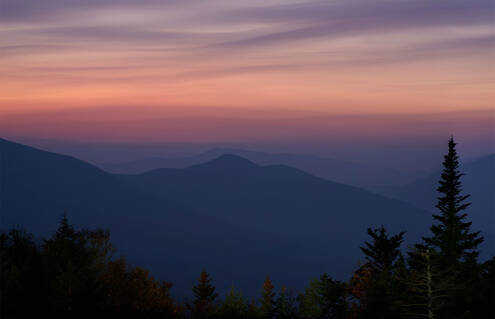
The smaller the particle, the more likely it is to get into the lower airways and be incorporated into our circulation, and cause a host of issues.
Laura M. Paulin, MDThe Canadian wildfires are polluting the air we breathe.
Wildfire smoke holds a mix of hazardous air pollutants drifting over New England this summer. It can travel hundreds of miles, and on some days, the smoke is visible here as a thin haze.
At the very least, your eyes, nose and throat can get irritated. Even if you’re healthy, exposure to wildfire smoke can also potentially cause lung problems and pulmonary inflammation.
Your risk is even greater if you’re pregnant, have asthma, heart disease or another existing health condition.
That’s why experts urge caution.
“Gauge your activity level based on your underlying health and degree of susceptibility to air pollution exposures,” said Laura M. Paulin, MD, a pulmonologist at Dartmouth Health’s Dartmouth Hitchcock Medical Center, in a June interview with The Keene Sentinel.
Why is wildfire smoke dangerous?
Wildfire smoke already causes as many as 675,000 premature deaths a year worldwide, according to 2024 research.
Wildfire smoke includes particulate matter, ozone and other hazardous pollutants.
Particulate matter, known as PM 2.5, is made up of tiny particles—with diameters that are generally 2.5 micrometers and smaller—that can penetrate deep into your lungs and enter your bloodstream.
Ozone, an odorless and colorless gas, can irritate your respiratory system.
“The smaller the particle, the more likely it is to get into the lower airways and be incorporated into our circulation, and cause a host of issues,” Paulin said in a 2021 Dartmouth Health Climate and Health webinar.
The mucus and hairs in your nose, as well as the mucus and cilia in your upper airway, can trap larger particles. But smaller particles can bypass your bodily defenses.
Short-term exposure from wildfire smoke can lead to bronchitis, trigger asthma and create other serious health issues, as microscopic pieces of dust, dirt, smoke and soot from wildfires can become destructive when entering the bloodstream. These airborne, invisible particles can also damage the kidneys, heart and lungs.
The Centers for Disease Control and Prevention (CDC) said breathing in wildfire smoke can immediately cause:
- Asthma attacks
- Chest pain
- Coughing
- Fast heartbeat
- Headaches
- Irritated sinuses
- Runny nose
- Scratchy throat
- Stinging eyes
- Tiredness
- Trouble breathing
- Wheezing
Subscribe to the Living Better newsletter
Your trusted resource for reliable and up-to-date health and wellness information in the Northeast. Get it delivered to your inbox every other week.
Who’s at risk?
“Air pollution is a leading—but potentially modifiable—risk factor for death,” Paulin warned in the 2021 webinar. Air pollution “...is not just in developing countries. This is happening here in the United States.”
According to the CDC, people most at-risk from wildfire smoke include:
- Individuals with chronic conditions like asthma, Chronic Obstructive Pulmonary Disease (COPD), diabetes, heart disease or chronic kidney disease
- Children
- Older adults
- Pregnant people.
A 2024 Dartmouth Geisel College of Medicine-led study, published in the journal BMC Public Health, shows that even small effects from exposure to various types of air pollution can have adverse health impacts on vulnerable groups, such as mothers and their babies.
Why are the risks greater for some people?
During pregnancy, the body naturally experiences higher respiratory rates and rises in blood and plasma volumes, which can increase vulnerability to harmful pollutants. Exposure to wildfire smoke may also harm the developing fetus.
Meanwhile, kids are at risk because their organs—including their lungs—are still in development.
If you have diabetes, air pollution can reduce insulin production and trigger inflammation, preventing your body from converting blood glucose into energy.
And older adults are at increased risk from wildfire smoke because pre-existing lung and heart diseases are more common. Also, our body’s defense mechanisms decline with age.
How to protect yourself
Familiarize yourself with tools such as the U.S. Air Quality Index (AQI) and be aware of your own limitations and the dangers of breathing in wildfire smoke.
Air quality ratings are defined as:
- "Good" AQI is 0-50
- "Moderate" AQI is 51-100
- "Unhealthy for Sensitive Groups" AQI is 101-150
- "Unhealthy" AQI is 151-200
- "Very Unhealthy" AQI is 201-300
- "Hazardous" AQI greater than 300
For example, in late July in Massachusetts, Boston, Brockton, Weymouth and Fall River AQIs reached over 150, which is considered unhealthy.
Experts also say to think twice before you go out for a run, bike ride or hike when air quality drops.
“When we exercise, we’re breathing heavier and more through the mouth, bypassing the nose’s natural defenses and inhaling a larger particle load,” Paulin said in a 2023 interview with Dartmouth College magazine, about the Canadian wildfires two years ago.
When wildfires reduce air quality, you can reduce your exposure by:
- Staying indoors
- Keeping windows and doors closed
- Using high-efficiency filters to capture fine particles from smoke if you have a central air conditioning system or a room unit
- Not burning candles or using gas, propane, woodburning stoves or fireplaces at home
- Not using aerosol sprays, frying or broiling meat, smoking tobacco products or using a vacuum
- Wearing a well-fitted mask outdoors
- Installing an air purifier indoors.
“If we, as healthcare professionals, are recommending people don’t go outside, it’s important to be cognizant of what people are doing indoors in terms of creating more particle load,” Paulin said.
“We recommend people stay inside and don’t smoke or burn anything in the house such as candles and wood,” she added.
How wildfire smoke is impacting the U.S.
Wildfire smoke affects more than 1.5 million people across the U.S. who are living in locations routinely exposed to extremely heavy smoke days.
Researchers have also found that since 2016, wildfire smoke has slowed or reversed air quality improvements in 35 states.
PM 2.5 from wildfire smoke has risen over the past 10 years, especially in the western U.S. And an increasing number of cities previously known for clean air, like Minneapolis, are now facing dangerous pollution levels in 2025, according to a new report by the American Lung Association (ALA).
The ALA's State of the Air report found that 156.1 million people—46 percent of the population—now live in counties with failing grades for ozone or particle pollution, nearly 25 million higher than last year. This is mainly because of extreme heat, drought and wildfires.
As Canada’s wildfire season continues, officials forecast above normal temperatures to last until September across most of Canada.
The good news? This year’s wildfires are not expected to be as severe as 2023, the worst in Canada’s history.
Resources & Related Stories
AirNow (the federal government’s air-quality monitoring site)
Environmental Protection Agency’s Fire and Smoke Map
New Hampshire Air Quality Forecast
Vermont Department of Health Air Quality Information
What Canadian Wildfires Signify for Climate, Public Health (2023)


